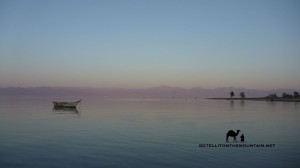The Sinai
 The Sinai is the jagged tooth of wilderness between Africa and Asia; a frontier of rugged mountains and wild, windswept deserts whose epic legends have echoed through the ages. It has been ruled as part of Egypt since the times of the Pharaohs 4000 years ago but even so, it’s always been something of a detached province; a land in itself, far removed from the life and politics of the Nile Valley. Cairo governments have always overlooked the Sinai – from early times to today – and as such it has its own distinctive people, culture and traditions. Egypt and the Sinai, mainland Egyptians and the Bedouin, often seem like entities out of sync. This section gives a sketch – and only a brief one – of the Sinai. To start, here’s the Sinai in 14 QUICK FACTS:
The Sinai is the jagged tooth of wilderness between Africa and Asia; a frontier of rugged mountains and wild, windswept deserts whose epic legends have echoed through the ages. It has been ruled as part of Egypt since the times of the Pharaohs 4000 years ago but even so, it’s always been something of a detached province; a land in itself, far removed from the life and politics of the Nile Valley. Cairo governments have always overlooked the Sinai – from early times to today – and as such it has its own distinctive people, culture and traditions. Egypt and the Sinai, mainland Egyptians and the Bedouin, often seem like entities out of sync. This section gives a sketch – and only a brief one – of the Sinai. To start, here’s the Sinai in 14 QUICK FACTS:
1. The Sinai covers an area of about 61,000km2; it’s a bit smaller than Ireland.
2. The Sinai’s highest mountain is Jebel Katherina, at 2642m. Its second highest – which is also the second highest in Eygpt – is Jebel Umm Shomer: 2586m.
 3. The Sinai is a huge triangular peninsula with three distinct coastlines: in the north, it borders the Mediterranean. On the west, the Gulf of Aqaba and, on the east, the Gulf of Suez. Both the Gulfs are smaller branches of the bigger Red Sea.
3. The Sinai is a huge triangular peninsula with three distinct coastlines: in the north, it borders the Mediterranean. On the west, the Gulf of Aqaba and, on the east, the Gulf of Suez. Both the Gulfs are smaller branches of the bigger Red Sea.
4. Politically, the Sinai is split into two governorates: North Sinai and South Sinai.
5. The capital of North Sinai is El Arish. The capital of South Sinai is El Tur.
6. The Sinai’s highest mountains are all in the South. Most are red granite, with similar mountains found in mainland Egypt and Saudi Arabia. Some say the Red Sea is named after their colour.
7. Seven or eight Bedouin tribes live in South Sinai today. The North has more.
 8. The Monastery of St Katherine – high in the mountains of South Sinai – is probably the oldest working Christian monastery in the world. It was founded around 565AD by the Byzantine Emperor Justinian and has been going continuously ever since.
8. The Monastery of St Katherine – high in the mountains of South Sinai – is probably the oldest working Christian monastery in the world. It was founded around 565AD by the Byzantine Emperor Justinian and has been going continuously ever since.
9. Sharm el Sheikh, Dahab and Nuweiba are the Sinai’s big tourist towns. And they’re all on the Gulf of Aqaba coast.
10. The Gulf of Suez is home to El Tur, Abu Zenima and Abu Rudeis: these are industrial, administrative centres, not tourist towns.
11. St Katherine is the highest town in Egypt, at around 1500m.
12. South Sinai is the most biodiverse part of Egypt. About half the country’s plant species are found here and the mountains have over 20 endemic plant species found nowhere else in the world.
13. Wadi Feiran is a famous wadi on the west side of the Sinai, with its only working convent. It winds down from St Katherine to the coast and is also home to its biggest oasis; the ‘Pearl of Sinai’.
 14. The Sinai has some of the oldest rocks in the world. Its red granite mountains are about 600 million years old. In some areas, they might even be up to a billion years old. To put that in context, the earth itself formed around 4.6 billion years ago.
14. The Sinai has some of the oldest rocks in the world. Its red granite mountains are about 600 million years old. In some areas, they might even be up to a billion years old. To put that in context, the earth itself formed around 4.6 billion years ago.